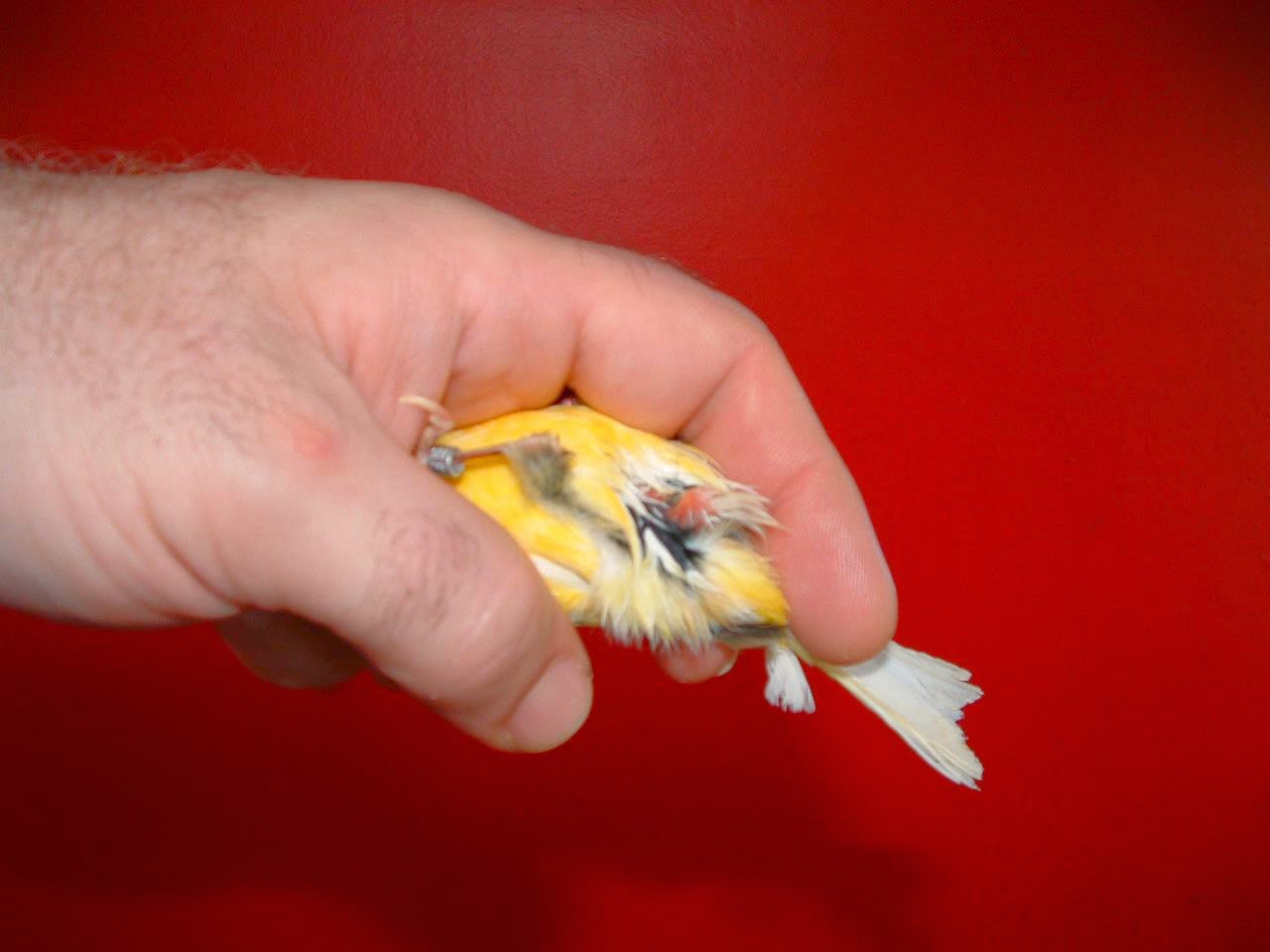Sexing in the Nest
Those who raise song breed canaries are interested in sexing the young birds just as soon as possible since removing the young males from the presence of their sisters and mothers is thought to allow for better song development. For this reason some song breeders have made a very thorough study of the evidence for determining sex just as early as possible. In fact, if this can be done before the chicks fledge, so much the better. There are probably as many methods for achieving this as there are advocates for an early separation of the genders. The following are two which I have come across, but I cannot vouch for the accuracy of either:
Line all the unfledged chicks from one nest up on a towel or some other surface they can get a foot hold on, and then observe their behavior. Those chicks which jump or scurry forward are males and those which remain fairly stationary are hens.
At banding time, those chicks which have the longest central toe will be males and those whose toes are more even in size will be hens.
Sexing Based on Early Song
Until canaries are fully weaned and caring for themselves (this can be more than a month after hatching), their voices are used pretty much in order to squeakily beg for food or to express such things as surprise, pain, or annoyance with a sibling. But sometime between independence and their nest feather molting time, the first attempts at song occur. This first song is known as sub-song, and has been described as a dreamy trilling sound which the young bird makes with eyes half closed in an almost napping state. The bird is clearly singing and its little throat becomes inflated in a dim reflection of what it looks like when a mature male sings. I have noted that, although this is a step in the development of mature male song, a significant proportion of young hens (as much as about 1/3 in my song canary lines) indulge in behavior which cannot be distinguished from emitting sub-song. They can dreamily trill with the best of them. So although it might serve as an early hint to gender, it cannot be regarded as definitive. It is not until the young males move into the next song learning phase, called plastic song, that song can become a bit more reliable as an indication of gender. With plastic song, the young males begin to incorporate adult phrases and passages into their song, even though the song is still not set. Although plastic song is more reliable when it comes to young canaries of known age, it should be noted that there is no bold line between sub-song and plastic song and that one flows slowly into the other over the course of weeks or even months, and some individual
Sexing by Color Appearance
It must be noted that the following method does not work with many canary breeds. However, it can be quite a useful indication of gender in some song canaries.
Most canary breeds have two feather types owing to a mutation which occurred at some time after the split between the song canary fancy and the type/posture/color fancy occurred. The mutation is one which happened in the second group, and due to its influence most of these breeds have individuals with intensive (also called “yellow” or “hard”) feathers and individuals with non-intensive (also called ”buff” or “soft”) feathers. All intensive birds, regardless of gender, appear to be more brightly colored. According to some authors the wild canary is said to have feathers in between the two extremes, while others claim that all wild canaries have non-intensive feathers. Either way, the feather texture of the wild bird causes a slight amount of dimorphism between the sexes; the effect is that the males seem to be washed with a slightly brighter yellow color while the hens seem to be washed with a slightly paler yellow. In reality the color is the same and what differs is the feather texture. The feather web is slightly wider in the hens and this causes the color to be a bit more diffused on the feather.
Because song breeds have not undergone the intensive mutation that the other canary breeds have, they too can be sexed by the appearance of the brightness of the yellow in their feathers. Obviously the slight difference is seen best on clear yellow birds, since they don’t have any dark pigment to obscure one’s view. If two yellow song canaries in adult feather, coming from the same family line, significantly differ in the brightness of the yellow, that which is paler overall will be the hen. Unfortunately, this method only works on related birds since different strains will be brighter or paler. Since the majority of waterslagers are yellow or have only small dark areas, this method is especially useful for this breed.
Sexing by Inspection
When dealing with sexually mature and conditioned birds this is the method which is closest to foolproof.
The following three photographs attempt to illustrate the difference between the sexes.
 Male:
Male:The male has a pseudo-penis which sticks up from the vent; it is about the diameter of a new eraser on the end of a pencil and is slightly longer.
Female Out of Condition:
The female, when not in condition, has a belly which appears dome-shaped above the vent.
Female in Condition for Breeding:
The female which is in breeding condition has a belly which is torpedo shaped, coming to a dull point at the vent. Rather than the rounded high dome that the out-of-condition hen has, the hen that is ready to breed has an even belly which smoothly narrows toward the rear.
Sebastian Vallelunga....http://www.westernwaterslager.com/text/Articles/Sexing.htm









